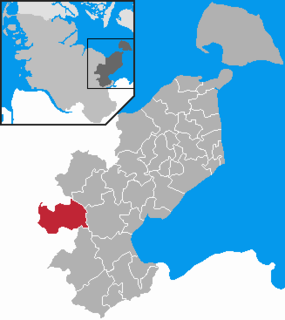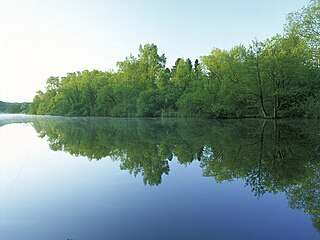

The Princes' Island [1] (German : Prinzeninsel) is a peninsula in the Großer Plöner See southwest of the town of Plön in the north German state of Schleswig-Holstein.

German is a West Germanic language that is mainly spoken in Central Europe. It is the most widely spoken and official or co-official language in Germany, Austria, Switzerland, South Tyrol (Italy), the German-speaking Community of Belgium, and Liechtenstein. It is also one of the three official languages of Luxembourg and a co-official language in the Opole Voivodeship in Poland. The languages which are most similar to German are the other members of the West Germanic language branch: Afrikaans, Dutch, English, the Frisian languages, Low German/Low Saxon, Luxembourgish, and Yiddish. There are also strong similarities in vocabulary with Danish, Norwegian and Swedish, although those belong to the North Germanic group. German is the second most widely spoken Germanic language, after English.

The Großer Plöner See or Lake Plön is the largest lake (30 km²) in Schleswig-Holstein, Germany. It is located near the town of Plön. Its main tributary, as well as its main outflow, is the River Schwentine.

Plön is the district seat of the Plön district in Schleswig-Holstein, Germany, and has about 8,700 inhabitants. It lies right on the shores of Schleswig-Holstein's biggest lake, the Great Plön Lake, as well as on several smaller lakes, touching the town on virtually all sides. The town's landmark is Plön Castle, a chateau built in the 17th century on a hill overlooking the town.
Princes' Island was turned into a peninsula in the 19th century by the artificial lowering of the water level. It is about 2 km long and only about 30 m wide in places. At the southern end is the Niedersächsisches Bauernhaus ("Lower Saxon farmhouse") dating to the 17th century, which is now operated as a restaurant and breeds geese and moorland sheep of the Heidschnucke variety. Princes' Island is mainly forested, but some areas of the shoreline are also swampy. It is closed to motor traffic.
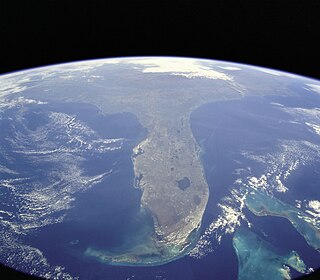
A peninsula is a landform surrounded by water on the majority of its border while being connected to a mainland from which it extends. The surrounding water is usually understood to be continuous, though not necessarily named as a single body of water. Peninsulas are not always named as such; one can also be a headland, cape, island promontory, bill, point, or spit. A point is generally considered a tapering piece of land projecting into a body of water that is less prominent than a cape. A river which courses through a very tight meander is also sometimes said to form a "peninsula" within the loop of water. In English, the plural versions of peninsula are peninsulas and, less commonly, peninsulae.

The Low German house or Fachhallenhaus is a type of timber-framed farmhouse found in Northern Germany and the Netherlands, which combines living quarters, byre and barn under one roof. It is built as a large hall with bays on the sides for livestock and storage and with the living accommodation at one end. The Low German house appeared during the 13th to 15th centuries and was referred to as the Low Saxon house (Niedersachsenhaus) in early research works. Until its decline in the 19th century, this rural, agricultural farmhouse style was widely distributed through the North German Plain, all the way from the Lower Rhine to Mecklenburg. Even today, the Fachhallenhaus still characterises the appearance of many north German villages.
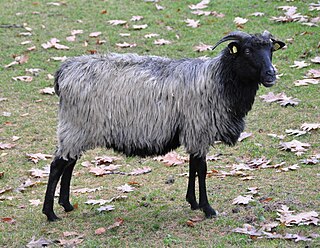
The Heidschnucke is a group of three types of moorland sheep from northern Germany. Like a number of other types from Scandinavia and Great Britain, they are Northern European short-tailed sheep. The three breeds of Heidschnucke are:
The sons of the last German Emperor William II learned agricultural skills on the old farm which their father had purchased, while they lived in the Princes' House on the bank of the lake. The southern tip of the Prinzeninsel was a favourite spot of the last German Empress, Augusta Victoria of Schleswig-Holstein. The current owner of the island is Georg Friedrich, Prince of Prussia.
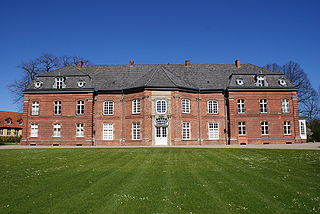
The Princes' House in Plön in the North German state of Schleswig-Holstein is a former royal summer residence in the grounds of the park at Plön Castle. It is the only surviving maison de plaisance in Schleswig-Holstein.

Augusta Victoria of Schleswig-Holstein was the last German empress and queen of Prussia by marriage to Wilhelm II, German Emperor.

Georg Friedrich Ferdinand, Prince of Prussia is the current head of the Prussian branch of the House of Hohenzollern, the former ruling dynasty of the German Empire and of the Kingdom of Prussia. He is the great-great-grandson and historic heir of Wilhelm II, the last German Emperor and King of Prussia, who was deposed and went into exile upon Germany's defeat in World War I in 1918.
The boats of the Großer-Plöner-See-Rundfahrt, that make round trips of the lake, land near the Niedersächsisches Bauernhaus. At the farmhouse is an inscription: melior nihil nihil homini libero dignius agricultura 1901: "Nothing is better, nothing more worthy of free people, than farming."
The peninsula also has an outdoor swimming pool, which goes under the name of Prinzenbad ("Princes' pool"), because the Hohenzollern sons learnt to swim there. It has a fine sandy beach on the west side where the lake bed shelves very gently so that, 30 metres offshore, the depth is just 1.20 metres. Whilst from 1947-1963 there was a campsite and restaurant here on a very small scale, bathers are now largely on their own. In the modern buildings that have replaced the old ones, there is, inter alia, a lifeguard station of the DLRG in Plon.
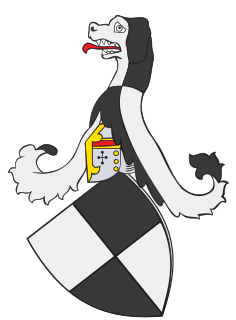
The House of Hohenzollern[ˈhoːəntsɔlɐn] is a German dynasty of former princes, electors, kings and emperors of Hohenzollern, Brandenburg, Prussia, the German Empire, and Romania. The family arose in the area around the town of Hechingen in Swabia during the 11th century and took their name from Hohenzollern Castle. The first ancestors of the Hohenzollerns were mentioned in 1061.

